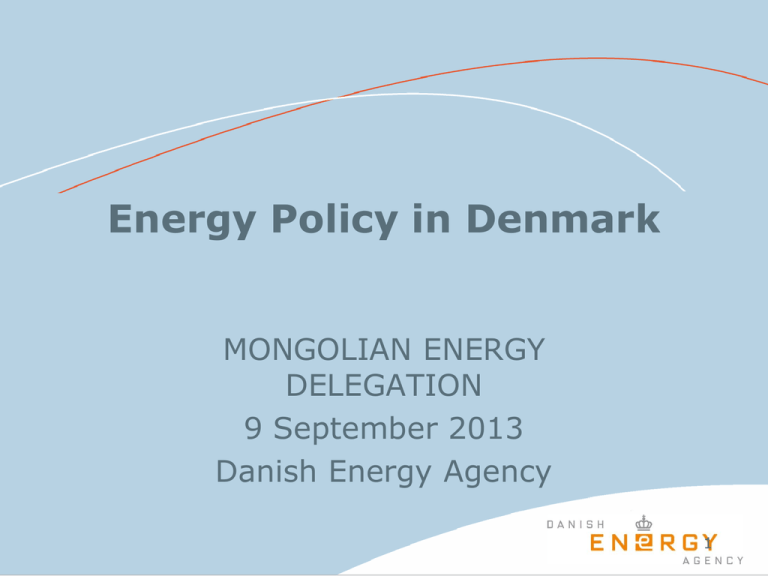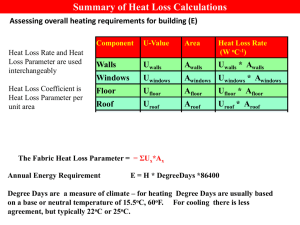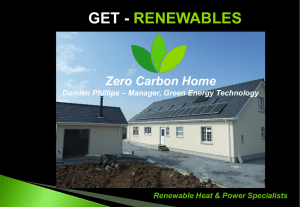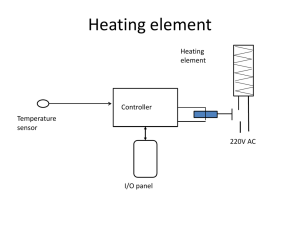Energy Policy in Denmark
advertisement

Energy Policy in Denmark MONGOLIAN ENERGY DELEGATION 9 September 2013 Danish Energy Agency 1 Program • Welcome by Director Energy Technology Anton Beck • Danish Energy Policy with emphasis on District Heating by Senior Adviser Niels Bisgaard Pedersen • Integration of wind and solar energy in the power and heat supply by Senior Adviser Anders Højgaard Kristensen The Danish District Heating System Key figures Covers 2/3 of heat demand for space heating and hot water in residential sector Approximately 130 PJ (20% of final energy consumption) 45% 20% 20% 15% CHP from from from from 11 large scale CHP plants ~600 small scale CHP – mainly natural gas heat only boilers – mainly biomass recovery of industrial waste heat and industrial Biomass 28% Heating installations in residential homes 1000 Units 3000 2500 2000 1500 1000 500 0 1981 Oil boilers 1990 Natural gas boilers Source: Statistics Denmark 4 2000 District heating 2011 Other Decoupling Economic Growth and Energy Consumption 5 Background • Energy crisis 1973-74 • 99% dependent on oil imports, • Low energy efficiency in production and consumption • Economic crisis and high unemployment • SUSTAINABILITY • Efficiency • Domestic resources, natural gas replaces oil • Renewable Energy Measures to decouple economic growth and energy consumption • Decentralisation • Energy Taxation • Modern Energy Legislation for electricity and heat sectors in the late 70ties • Heat Planning, • District Heating • Combined Heat and Power production • Energy Efficiency in buildings, households and industry • Diversified Supply Infrastructure 1985 – 2009 Decentralisation Municipal heat planning • New regulation heat supply in 1979 • Allocation heat supply in geographical areas based on economic principles • Definition of areas where different forms of heat supply should be prioritised • Location of heat supply installations and pipelines • ‘Zoning’ of heat supply in DH, natural gas and individual solutions Heat Plannning - Zoning 1) 3) 2) District Heating generation from 1975 11 CHP share of thermal power and district heating production 100% 80% 60% 40% 20% 0% 1990 '95 District heating 12 '05 '00 Electricity '11 Energy consumption for heating dwellings Climate adjusted Index 1990=100 150 Building codes First code 1977 Next 2015 - 2020 100 50 0 1990 '95 Heated floor space Final energy consumption per m2 '00 '05 Final energy consumption Subsidies for energy improvement of buildings 13 '11 Today the energy demand in buildings is only 25% of the demand in 1977, before the subsidies Electricity and Natural Gas Market • 1998 package • 2005 package • Interconnections • Power exchanges • NordPool • http://www.energinet.dk/Flash/Forside/ind ex.html?target=el_net • http://www.statnett.no/en/The-powersystem/Production-andconsumption/State-of-the-Nordic-PowerSystem-Map/ Share of renewable energy % 25 20 15 10 5 0 1990 '95 '00 '05 Share of renewable energy according to the EU method of calculation PJ 120 100 80 60 40 20 0 Electricity and district heating Wind 15 Straw Wood Biogas Final energy consumption Waste Other renewables '11 Energy Agreement 2020 • Broad political consensus about an ambitious green transition up to 2020 and a vision for 2050 • 12% reduction of energy consumption in 2020 compared to 2006 • 35% renewable energy in energy production in 2020 • 50% wind energy in the electricity production in 2020 • 100% renewable energy supply in 2050 • Fossils fuels will be phased out The Future of District Heating ? 2) 1) 1) New customer in existing areas 2) Extension of existing areas 3) New district heating areas HAS THE POTENTIAL for DH in DK BEEN EXHASUSTED WITH CURRENT TECHNOLOGIES ? 3) 2nd round - Heat Planning today • Heat planning had low focus for many years. Now 2nd round has begun • District Heating is again the key • New drivers: Green cities – strong interest in many municipalities • National driver: policy on phasing out fossil fuels • Flexibility tool for large amounts of wind power in the electricity system • District heating enables large scale use of renewables, e.g. biomass and solar heating • Competitive advantage due to no excise tax on biomass • Significant tax reduction on electricity to DH boilers under certain conditions Fuels used for District Heating: Development 1990-2011 100% 80% 60% 40% 20% 0% 1990 '95 Oil 19 Natural gas '00 Coal '05 Renewable energy and waste '11 District heating and wind power • Huge challenge to integrate increasing amounts of wind 30% in 2012 and 50% in 2020 • The main tool is the strong interconnectors and integration into the Nordic Power market • The district heating system will serve as important flexibility tool • Heat storage already in place, enabling flexibility between power generation and heat demand for up to 8-10 hours • Legislation on electricity taxation changed excluding tax on electricity used for district heating under certain conditions • A small no of electric boilers with a total capacity of around 200-300 MW being installed these years. District heating and wind power • Large scale heat pumps foreseen to be introduced - will keep efficiency high and will operate during longer periods • Substitution of CHP with electricity boilers has double effect • Drives power generation down (at CHP plant) • Introduces new demand Solar heating – a feasible supplement • Today big interest in large scale solar heating collectors for district heat generation • Mainly as supplement, but also as main source with seasonal storage • Driver is lower cost of fuel and taxes. Cost of Natural gas is increasing • Size of 10.000-50.000 m2 • Total 300.000 m2 + 280.000 m2 under construction 22 Example – Gram District Heating 41.000 m2 solar collector 110.000 m3 heat storage Investment 93 mio DKK Cost reduction 15-25% Conclusion 1) District heating is part of the sustainability 2) Green Cities are very important in an efficient energy system • Heat Planning • Expansion of district heating reduced dependence of oil • Conversion to CHP was important element in deployment of domestic natural gas • Power and district heat generation integrated • Very high overall thermal efficiency • Flexibility and economic efficient • A new role for district heating • Important flexibility to wind integration • Possibility to use more biomass and other renewables







